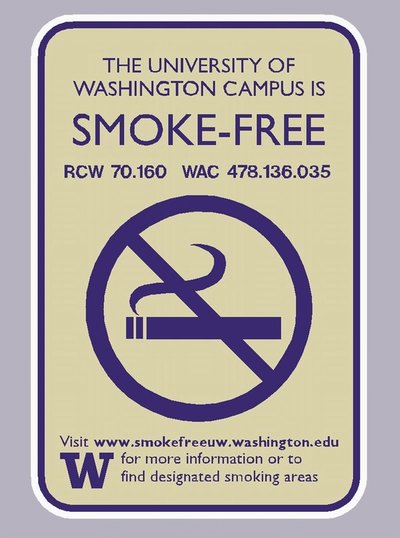October 11, 2007
UW is ‘nearly’ smoke-free
It’s well documented that smoking tobacco is one of the riskiest and deadliest behaviors around, contributing to over 30 percent of heart disease and strokes, nearly 90 percent of lung cancers and at least a third of other cancers. It has been declared the number one cause of preventable disease and death, and continues to be a major public health problem. Yet, quitting is one of the hardest things for smokers to do because a number of factors compound the addiction.
“Tobacco is the most addictive substance on the planet and cigarettes are the most highly engineered consumer product on the market,” said Dr. Abigail Halperin, director of the UW Tobacco Studies Program in the School of Public Health & Community Medicine. “Cigarettes are engineered for maximum addiction. They are also the only consumer product that, when used as directed, kills half of its users.”
Halperin, who teaches a class on Tobacco & Public Health, said it’s no wonder the success rates for people trying to break the tobacco habit are so low. “Seventy percent of smokers want to quit and 50 percent try to quit every year. Unfortunately, less than 5 percent succeed on their own. With help, the success rate can increase to 20 to 25 percent, but most people don’t realize that there is effective treatment available.”
Alan Marlatt, professor of psychology and director of the UW’s Addictive Behaviors Research Center, explained that addictions are physically as well as psychologically based, and that quitting is not just a matter of having will power.
“All addictions have the common element of dopamine release, which creates a sense of well-being in certain reward centers of the brain,” Marlatt said. “Because nicotine is a stimulant, it naturally causes people to smoke a lot more. Heroin addicts say giving up smoking is much more difficult than giving up heroin.”
In addition to the physical addiction, other factors conspire against the smoker — negative emotions such as anger, anxiety, depression — and social pressures of family, friends, co-workers, and others who smoke. “Many people try to manage their mood by self-medicating with nicotine, alcohol, or food,” Marlatt said, adding that “35 percent of relapse is caused by negative emotions.”
And, then, there are the urges. The smoker’s urges are triggered by situational cues, such as having a cigarette after a meal, with a drink, or at social events with friends and family. “The smoker is not just dealing with withdrawal, but also conditioning — think Pavlov’s dogs.”
Very few people are successful on their first attempt to quit, Marlatt said, noting that it takes persistence to succeed. “The first 90 days are the hardest. There’s a 60 percent chance of relapse in the first two weeks; by three months, it’s over 80 percent. However, studies show that if you keep trying, you’ll succeed. It takes eight serious attempts on average to quit.”
So what does it take to be successful? Developing a plan and following it leads to better outcomes, experts say.
“For most people to quit, it takes multiple attempts and a combination of approaches, to address the physical addiction, the psychological dependence, and behavioral habits,” said Mark Shaw, director of health education at Hall Health Primary Care Center. The center offers a comprehensive smoking-cessation program for staff, faculty, and students. Cost for the total program is $40. There is no charge for students, and most of the insurance plans offered by the UW cover the program for faculty and staff. To find out more, visit http://hallhealth.washington.edu/smokingcessation.
“The determinants of success include the smoker’s history of smoking, psychological awareness, and body chemistry,” Shaw said. “So a combined approach using the following is best: Nicotine replacement for cravings and withdrawal symptoms for the first six to eight weeks; a smoking cessation program for behavioral modification and support; and other medication if needed, such as the anti-depressant Zyban (bupropion) or the new nicotine receptor blocker, Chantix (varenicline) to address psychological cravings and to help people feel better during the cessation process.”
Participants in Hall Health’s smoking cessation program are encouraged to keep a smoking journal, logging the time, situation, and their mood before and after smoking, as well as charting their level of satisfaction on a seven-point scale.
Shaw said setting a quit date or goal for a month and giving oneself medium- and long-term rewards is part of an effective quitting strategy.
“Money is a motivation,” he said. “Add up the amount of money you save (multiply $5x365x years of life expectancy) by not smoking a pack a day and treat yourself.
“Look at a short-term goal, like saving the equivalent of tobacco expense per week at $20 to $30 per week. If you found a $20 bill, what would you spend it on — something without harm — a new CD, restaurant meal, and movies, something you enjoy. Longer term, this money could go toward a vacation, newer car, down payment on a house, or retirement accounts.”
In counseling, the smoker receives behavioral tools to deal with their addiction, trials, and relapses. They are taught to cope with their moods, social pressures, and urges by developing alternative coping strategies, such as exercising, meditating, and setting guidelines for their social activities.
“Relapse management is a must,” Marlatt said. “There’s an 80 to 90 percent chance of that happening. We have to ask ‘How are you going to deal with it?’ and give people skills and support. If you’re trying to behave and respond in a different way, don’t be surprised if you make mistakes,” Marlatt said. “Don’t give up. And get out of all or nothing thinking. Learn from your mistakes and try again.”
Shaw said the rewards of quitting are immeasurable.
“Along with the health improvements you have a feeling of being more in charge of your life, and of dodging the bullet before a spot on the lung or other smoking- related illness gets you.”
Resources
Hall Health Primary Care Center offers comprehensive smoking cessation program, http://hallhealth.washington.edu/smokingcessation.
The UWellness Web site provides smoking cessation programs and resources, http://www.washington.edu/admin/hr/benefits/wellness/smoking.html.
The UW Tobacco Studies Program offers courses, seminars and other tobacco control education and research resources, go to http://depts.washington.edu/tobacco/.
The Washington State Tobacco Quit Line provides free telephone cessation program for all state residents. Call 1-800-QUIT NOW (784-8669) or go to http://www.quitline.com/.
- The American Cancer Society’s Great American Smokeout is Nov. 16. http://www.cancer.org/docroot/subsite/greatamericans/smokeout.asp.


